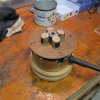I'm interested to hear if anyone has good or bad experience with shop made wooden or PVC jaws. I saw a magazine article that shows a jig for them, and the customization and cost factor are certainly appealing. Though not mentioned in the article, I imagine wood selection to be an important part of these jaws not exploding in ones face.
Thoughts?
Thoughts?


